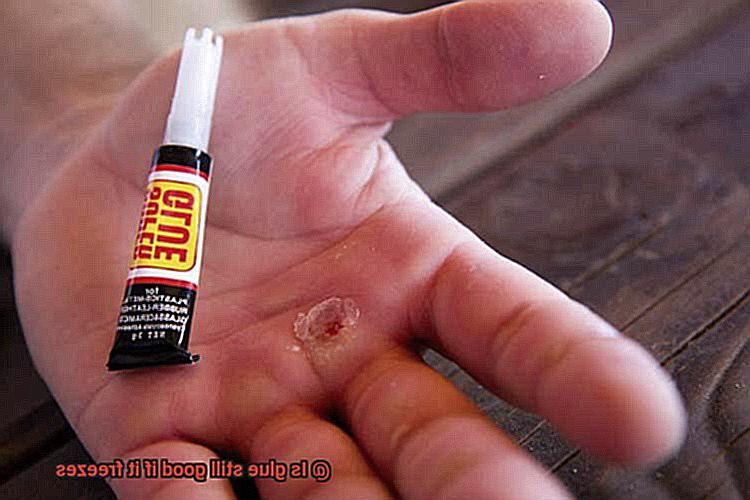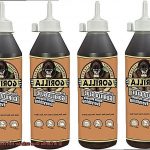Picture this: you’re all set to tackle a project, only to discover that your go-to glue has spent the night shivering in an icy workshop. Cue the panic. Now you’re left wondering, “Is my glue still good?”
If you’ve ever found yourself in a sticky situation like this, fear not. Today, we embark on a wild ride to uncover the truth about glue and its ability to brave freezing temperatures. Whether you’re a seasoned craft connoisseur, a DIY devotee, or just plain curious about adhesive science, this article is here to give you the lowdown.
We’ll dive deep into the effects of freezing on various glues – from everyday household brands to heavy-duty industrial sticklers – and unravel the mind-boggling ways freezing temperatures can mess with their chemical makeup. So grab yourself a steaming cup of cocoa and join us as we unravel the frosty secrets of glue.
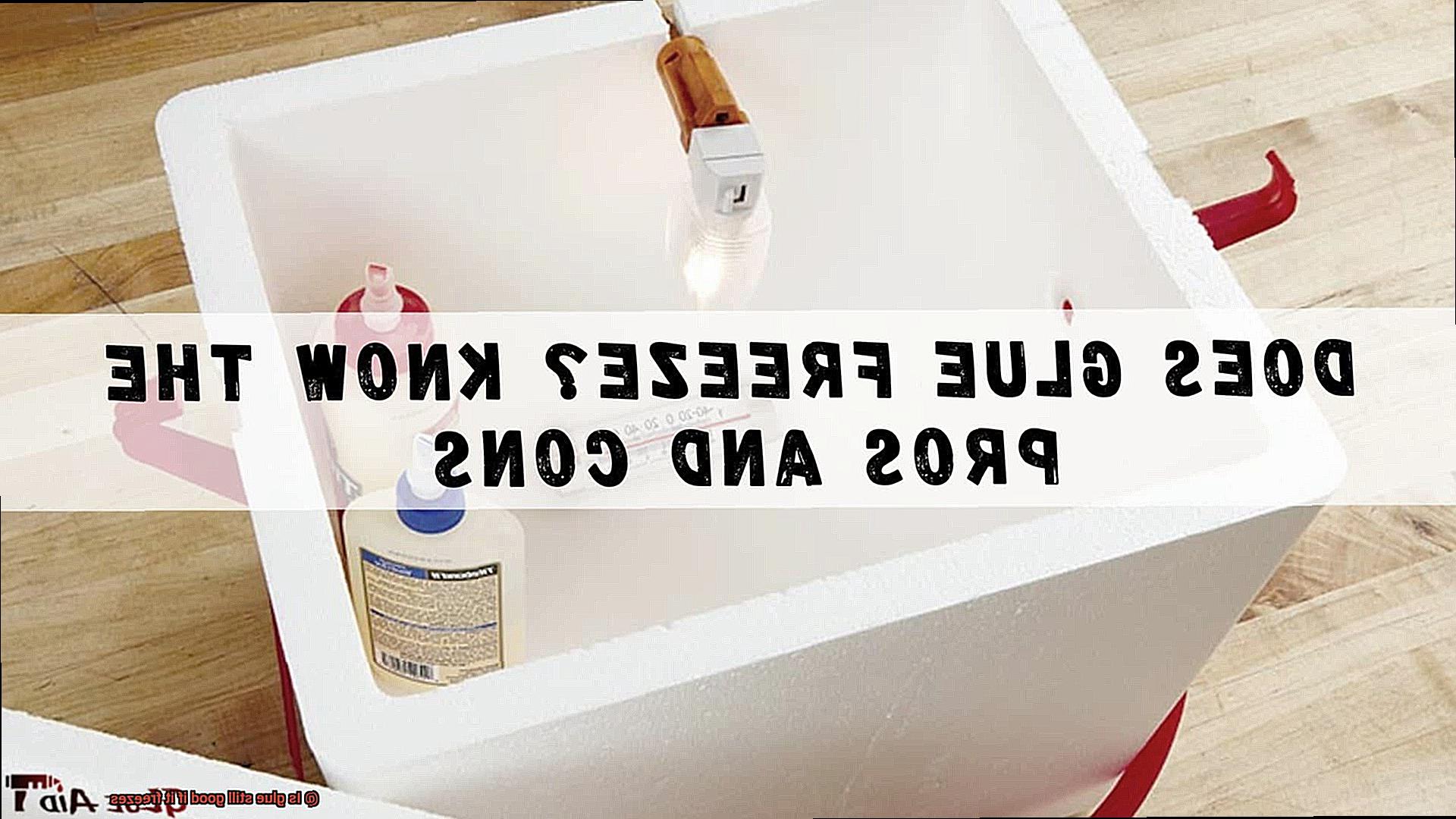
What is Glue?
Contents
Glue is a remarkable substance that possesses the incredible ability to bond and unite surfaces together. Whether you’re engaged in a creative craft project, fixing household items, or constructing furniture, glue is an indispensable tool in your arsenal. But what exactly is glue and how does it work its magic?
At its core, glue is an adhesive substance composed of different ingredients that work in harmony to create a strong and durable bond. The primary component of most glues is a polymer, which is a long chain of molecules that can be either natural or synthetic. This polymer acts as the backbone of the glue, providing the adhesive strength necessary for bonding.
There are various types of glue available in the market, each with its own unique properties and applications. Some common types include white glue (polyvinyl acetate), wood glue, super glue (cyanoacrylate adhesive), epoxy, and hot glue. These different types of glues are specially formulated to cater to specific needs and materials.
White glue, also known as school glue or PVA glue, is a water-based adhesive that dries clear. It is commonly used for crafts, paper projects, and general household repairs. Wood glue, on the other hand, is designed specifically for bonding wood surfaces. It has a high bonding strength and is resistant to moisture, making it ideal for woodworking projects.
Super glue is a fast-acting adhesive that forms an instant bond when it comes into contact with moisture. It is perfect for bonding small objects such as ceramics, plastics, and metals. Epoxy, on the other hand, consists of two components – a resin and a hardener – that combine to create a strong and durable bond resistant to heat, chemicals, and water. It finds application in construction, automotive repairs, and industrial settings.
Lastly, hot glue is applied in its molten state using a glue gun and solidifies upon cooling to form a strong bond. It is commonly used in crafts, floral arrangements, and fabric projects due to its quick setting time.
Glue can come in various forms such as liquid, gel, or stick, depending on its intended use. It is crucial to select the right type of glue for a specific project to ensure optimal bonding performance.
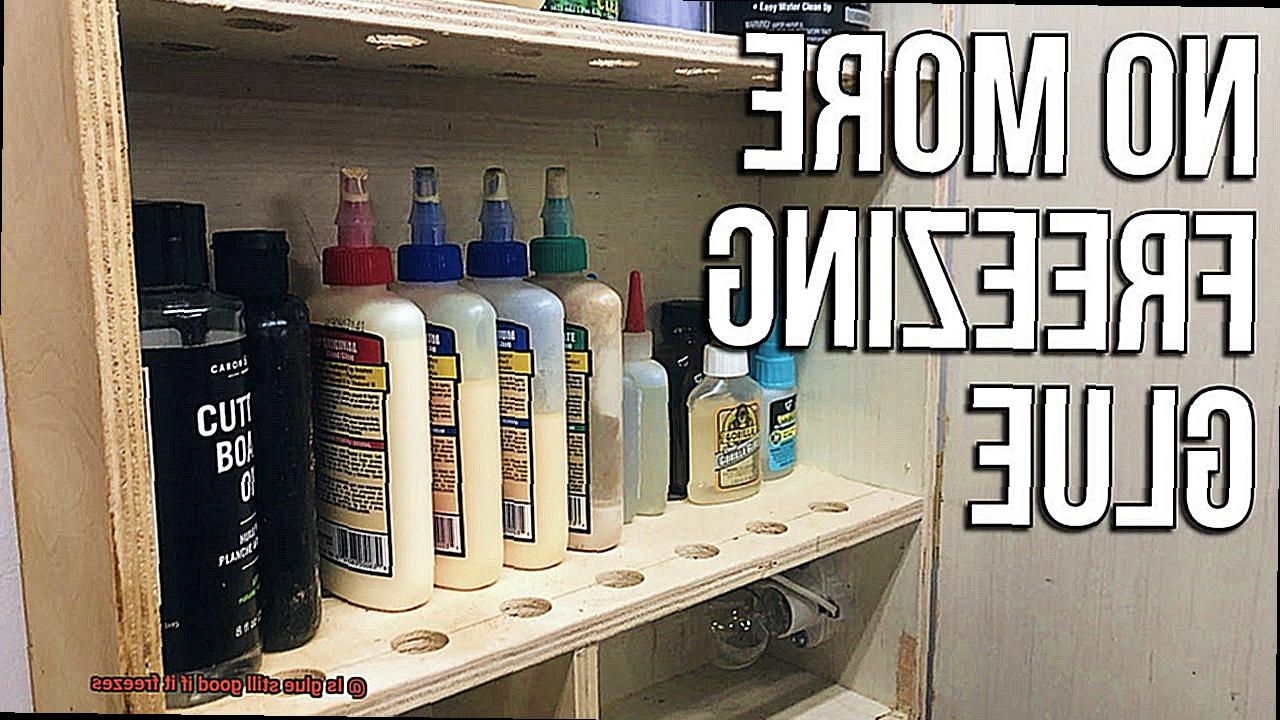
How Does Freezing Affect Glue?
Glue, the unsung hero of crafting and repair projects, has a secret weakness – freezing temperatures. Yes, even our favorite adhesive can lose its powers when exposed to frigid conditions. But fear not, fellow glue enthusiasts, for I am here to shed some light on this chilling topic.
When glue encounters freezing temperatures, it’s like facing a supervillain that wreaks havoc on its properties. The components that make up glue – polymers, resins, and solvents – can suffer a meltdown. Okay, maybe not an actual meltdown, but they can definitely break down or separate. This makes the glue as brittle as an ice cube and it loses its adhesive prowess. So, when the glue thaws, it might not be able to form that strong bond you were counting on.
But wait, there’s more. Freezing can also cause the solvents in glue to evaporate or become less effective. These solvents are responsible for keeping the glue nice and liquidy, making it easy to apply. When they vanish into thin air due to freezing temperatures, well, let’s just say you’ll have a tougher time working with rock-hard glue.
Now, picture this: ice crystals forming within the glue. These pesky crystals disrupt the structure of the adhesive and weaken its bonding capabilities. So when the glue thaws and you’re relying on it to hold things together, those weakened areas might give way faster than a snowflake in springtime.
But fear not. Not all glues are created equal when it comes to freezing temperatures. Some glues, like superglue (cyanoacrylate) are more resistant to the cold and can maintain their powers even after exposure to low temperatures. However, other glues – like white craft glue or wood glue – are more vulnerable to freezing and might need some extra TLC.
To protect your precious glues from a life in the freezer, store them in a temperature-controlled environment. A cool, but not freezing, location will help preserve their powers. And if your glue has already suffered a chilly encounter, thaw it slowly at room temperature and give it a test run before entrusting it with an important project.
Different Types of Glue and their Freezing Points
Glue is a versatile adhesive used in various applications, from crafting to industrial use. However, when exposed to freezing temperatures, glue can undergo changes in its consistency and effectiveness. In this article, we will explore the different types of glue and their respective freezing points.
White Glue (PVA Glue):
White glue, also known as PVA glue, is a water-based adhesive commonly used in arts and crafts. It typically has a freezing point around 32°F (0°C). When white glue freezes, it can become thicker or clumpy, making it challenging to use for bonding purposes. Additionally, the frozen glue may lose some of its adhesive properties and be less effective at holding materials together.
Super Glue (Cyanoacrylate Adhesive):
Super glue is a fast-drying adhesive that forms a strong bond between surfaces. It has a lower freezing point compared to white glue, typically around -40°F (-40°C). Freezing super glue can cause it to become brittle and lose its ability to bond materials effectively. Therefore, it is important to store super glue in a cool and dry place to maintain its quality.
Epoxy Glue:
Epoxy glue is known for its strong bonding properties and is commonly used for various materials. It consists of two components, a resin and a hardener, which need to be mixed together before use. Epoxy glue has a higher freezing point compared to white glue or super glue, usually around 50°F (10°C) or higher. While epoxy glues are less likely to freeze under normal conditions, extreme cold temperatures can still affect their performance.
Hot Glue (Hot Melt Adhesive):
Hot glue, or hot melt adhesive, is often used in crafts and DIY projects. It is applied in a molten state and solidifies as it cools down. The freezing point of hot glue varies depending on the specific formulation, but it is generally above room temperature. Therefore, hot glue is less likely to freeze under normal conditions.
Wood Glue and Fabric Glue:
Wood glue and fabric glue also have their own freezing points. Wood glue typically has a freezing point similar to white glue, while fabric glue may have a slightly lower freezing point depending on the brand and formulation.
The Consistency of Frozen Glue
Glue is the unsung hero of many DIY projects, holding our creations together with its magical adhesive powers. However, when exposed to freezing temperatures, glue can undergo a dramatic change in consistency, turning from a reliable adhesive into a clumpy, ineffective mess. In this blog post, we will unravel the science behind this phenomenon and explore which types of glue are more resilient to freezing temperatures.
Unraveling the Science:
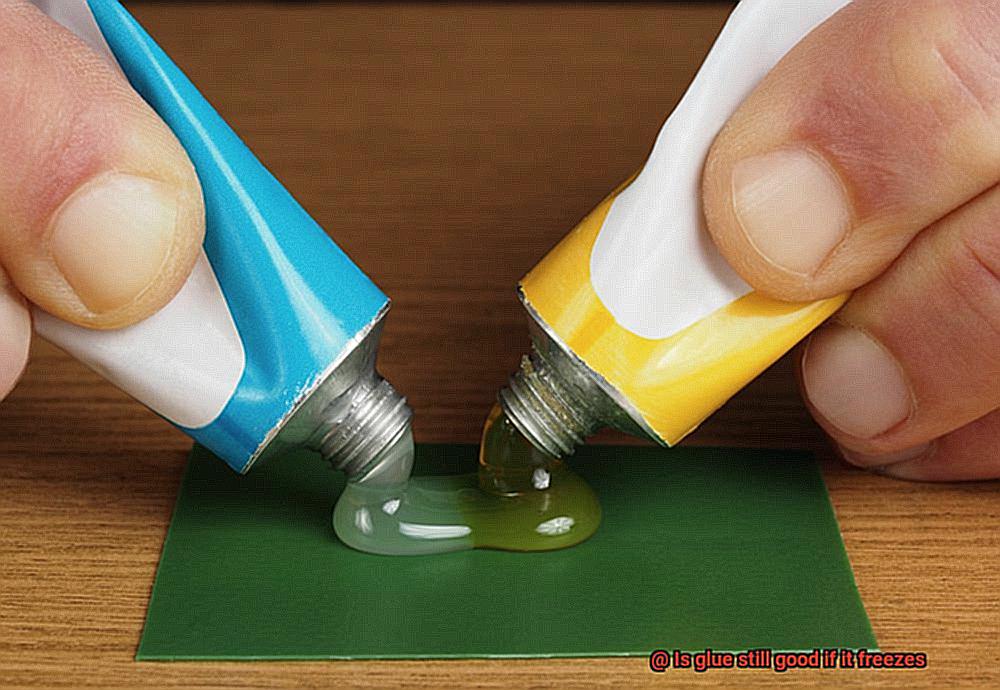
Glue is a complex mixture of polymers, solvents, and additives, all working together to create a strong adhesive bond. When subjected to freezing temperatures, the solvents within the glue can separate from the polymer matrix. This separation leads to changes in texture and effectiveness. The once-smooth glue can become clumpy or grainy, making it challenging to spread evenly. Additionally, frozen glue may lose its ability to create strong bonds, resulting in disappointing results for any project.
Not All Glues Are Created Equal:
Different types of glue exhibit varying responses to freezing temperatures. For example, super glue, also known as cyanoacrylate glue, is particularly sensitive and may become completely unusable after freezing. On the other hand, epoxy adhesives demonstrate more resilience and can withstand freezing temperatures without significant changes in their consistency or adhesive properties.
Testing Your Frozen Glue:
If you find yourself faced with frozen glue, there is still hope. Thawing it at room temperature allows you to observe its texture and adhesive performance. If the thawed glue appears smooth and spreads easily without any noticeable clumps or changes in consistency, it may still be suitable for use. However, it is crucial to conduct a small test on an inconspicuous area to ensure that the adhesive strength meets your requirements.
The Adhesive Properties of Frozen Glue
Glue, the unsung hero of our crafting endeavors, is a versatile adhesive that we rely on for countless projects. But what happens when this trusty companion is exposed to freezing temperatures? Brace yourselves, glue enthusiasts, as we embark on a journey into the intriguing world of frozen glue.
Imagine reaching for your bottle of glue in the back of your garage, only to discover it has been left out in the cold. What lies in store for this once reliable adhesive? Well, freezing temperatures can cause some significant changes to the properties of glue.
When glue freezes, its liquid components can separate, resulting in a loss of homogeneity. This means that the glue may not bond as effectively once applied. Your masterpiece may suffer from weaker adhesion than expected. Ah, the frustration.
But that’s not all – frozen glue can also become more brittle and prone to cracking once it thaws. Picture spending hours piecing together a delicate model, only to have it crumble like a fragile snowflake because your glue didn’t survive its icy encounter. Heartbreaking indeed.
In addition to weakened adhesion and increased brittleness, freezing temperatures can alter the viscosity of glue. Some glues may become thicker or more difficult to spread evenly after being frozen. Instead of smoothly applying that perfect layer of adhesive, you might end up with clumps and uneven coverage. Not exactly ideal for our projects, right?
Before we spiral into despair, let’s talk about silver linings. Not all glues are equally affected by freezing temperatures. Some types are more resilient than others based on their composition and formulation.
To ensure optimal performance, it’s crucial to follow the manufacturer’s storage and temperature guidelines. They often provide specific instructions on how to store their glue and what temperatures it can withstand. So let’s not neglect those labels, folks.
If you do find yourself with frozen glue, don’t panic just yet. Thaw it slowly at room temperature before using it again. Avoid the temptation to speed up the process with heat sources like microwaves or ovens – this can further compromise its adhesive properties.
Before diving headfirst into your project, it’s always a good idea to test the adhesive strength of your thawed glue on a small, inconspicuous area. This way, you can ensure it’s still up to the task and won’t let you down when it matters most.
Of course, there will be cases where frozen glue is simply beyond redemption. If it fails the adhesive strength test or has drastically changed in consistency, it’s probably time to bid farewell and replace it with a fresh bottle.
Repeated Freezing and Thawing Cycles
Glue, a versatile tool that we rely on for various projects, can face challenges when exposed to repeated freezing and thawing cycles. When temperatures drop, glue can undergo changes in consistency and properties that affect its effectiveness. Picture opening a bottle of glue only to find it separated or lumpy – not exactly what you were hoping for, right?
Repeated freezing and thawing cycles can even lead to the breakdown of the adhesive properties of the glue. This means it may not bond as effectively or lose its strength over time. But don’t panic just yet. The extent of the damage depends on the type of glue you’re using.
Some glues, like certain wood glues or super glues, are more vulnerable to freezing damage. These types of glue contain water as a solvent, which can be affected by freezing temperatures. On the other hand, there are glues like epoxy or polyurethane-based adhesives that are known for their ability to withstand extreme temperatures, including freezing. These glues have different formulations that make them more resistant to temperature changes.
To make sure you’re using the right glue for freezing conditions, always check the manufacturer’s instructions or product label. They will usually indicate if the glue is suitable for use in low temperatures. If you’re unsure, it’s best to store your glue at room temperature to maintain its effectiveness.
Here’s a pro tip: if your glue has been frozen and shows signs of separation or changes in consistency, it’s time to let it go and grab a fresh batch. Trust us, it’s better to start with a reliable adhesive than risk a project falling apart due to compromised glue.
Storing Glue in a Temperature-Controlled Environment
Storing glue in a temperature-controlled environment is crucial to maintaining its optimal performance and adhesive magic. Glue enthusiasts know that this magical substance holds our projects together, whether it’s crafting a masterpiece or fixing something around the house. But did you know that temperature can make all the difference?
Let’s dive into the world of glue and explore why temperature matters. Freezing temperatures can wreak havoc on your glue. Imagine your glue separating or becoming lumpy – not exactly what you want when you’re trying to create a strong bond. Some glues may even lose their adhesion or become less sticky when exposed to freezing temperatures. Wood glue and epoxy, in particular, are more sensitive to freezing temperatures compared to super glue or rubber cement.
So, what’s the ideal temperature range for storing glue? Aim for a cozy climate between 50°F and 75°F (10°C and 24°C). Extreme temperatures, both hot and cold, can deteriorate the adhesive properties of glue, so it’s best to avoid them.
Don’t forget the importance of proper sealing. Moisture is a foe to glue’s integrity, leading to reduced bonding strength or even complete failure. Protect your glue from moisture exposure by using airtight containers or sealable bags.
If you suspect your glue has been exposed to freezing temperatures, conduct a test before using it for important projects. Apply a small amount onto a scrap material and observe its bonding performance. If it appears lumpy, separated, or doesn’t adhere properly, it’s time to say goodbye and bring in a fresh batch.
Remember to check the manufacturer’s instructions for specific storage recommendations as different brands may have variations in their formulations. By storing your glue in a temperature-controlled environment, sealing it properly, and conducting tests when necessary, you’ll ensure that your glue remains in top-notch condition, ready to work its adhesive magic whenever you need it.

Thawing Frozen Glue
Thawing frozen glue can be a frustrating task, but fear not. I have some good news for you – it is possible to bring your glue back to life. However, it’s important to understand why frozen glue is such a hassle in the first place.
When glue freezes, it undergoes chemical changes that can interfere with its adhesive powers. The water content in the glue expands and forms pesky ice crystals that can ruin its stickiness. So, how do we remedy this situation?
The key is gentle warming. Avoid exposing the glue to high temperatures or direct heat sources, as this can do more harm than good. Instead, find a warm room or create a warm water bath to slowly thaw your frozen glue. Patience is crucial here – rushing the process could result in weakened bonding strength or inconsistent performance.
Once your glue is thawed, make sure to let it thaw completely. This ensures that any remaining ice crystals melt away and don’t interfere with the adhesive properties of the glue. Using partially thawed glue can lead to subpar results, so be thorough in this step.
It’s important to note that not all glues are created equal when it comes to freezing and thawing. For example, Elmer’s white glue can usually handle being frozen and thawed without much trouble. However, always give it a visual and sniff test before using it again. If it appears clumpy, watery, or has an unusual smell, it’s time to discard it and grab a fresh bottle.
On the other hand, more complex glues like epoxy or super glue may not fare well after freezing. These glues often contain reactive ingredients that can become unstable when exposed to extreme temperatures. Thawing and using these glues after freezing could result in weaker bonds or total failure.
To avoid the hassle of freezing glue in the future, store it in a temperature-controlled environment. Aim for room temperature or slightly above. Additionally, make sure to seal containers tightly after each use to minimize air exposure and moisture absorption.
If you frequently work in colder environments and are concerned about freezing glue, some manufacturers offer specialized formulas that are specifically designed to withstand freezing temperatures. Look for glues labeled as “freeze-resistant” or “freeze-thaw stable” to save yourself from future thawing headaches.
1nEgFzKl60g” >
Conclusion
When it comes to freezing glue, the answer is not so straightforward. While some types of glue may be unaffected by freezing temperatures, others can suffer from changes in consistency and effectiveness. The freezing process can cause the glue to separate or become lumpy, rendering it useless for its intended purpose. Furthermore, the freeze-thaw cycle can weaken the adhesive properties of the glue, making it less reliable when bonding materials together.
It’s important to note that not all glues are created equal. Different types of glues have different compositions and formulas, which can react differently to freezing temperatures. For example, traditional white glue or wood glue may be more susceptible to damage from freezing compared to specialized adhesives like super glue or epoxy.
Imagine this scenario: you’re working on a project that requires a strong bond between two surfaces. You reach for your trusty bottle of glue, only to discover that it has been accidentally left in a freezing cold garage overnight. As you inspect the bottle, you notice clumps and separation within the once smooth liquid. This is a clear indication that the glue has been compromised by the freezing temperatures.
Freezing can alter the chemical structure of certain glues, affecting their ability to adhere properly. The frozen state causes water molecules within the adhesive to expand and form ice crystals, disrupting the integrity of the glue’s composition. When this happens, you’ll likely find that your frozen glue no longer spreads smoothly or dries as effectively as it should.
In addition to consistency issues, frozen glue may also lose its adhesive strength over time. Each freeze-thaw cycle weakens the bond between molecules within the adhesive, leading to reduced stickiness and overall performance. So even if your frozen glue appears somewhat usable after thawing, it may not provide the same level of reliability or durability as before.
To avoid encountering these problems with frozen glue, it’s best to store your adhesive products in a controlled environment away from extreme temperatures. Keeping them in a cool, dry place will help maintain their integrity and ensure they remain effective when you need them most.
In conclusion, freezing can have detrimental effects on many types of glue. While some glues may survive the freezing process relatively unscathed, others can suffer from changes in consistency and adhesive strength. To avoid disappointment and wasted time on your projects, it’s wise to take precautions and store your glue properly.

